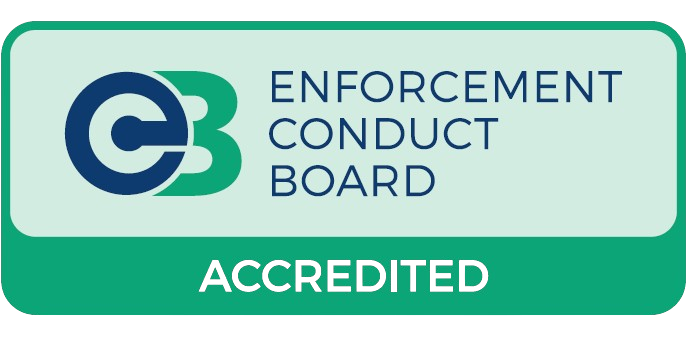What are the Proposed Changes for Bailiffs (Enforcement Agents)?
Background. The current framework was created by the 2014 reforms (Tribunals, Courts and Enforcement Act 2007, Sch.12; Taking Control of Goods Regulations and Fees Regulations 2014). Since then the Ministry of Justice and the Enforcement Conduct Board (ECB) have explored further changes around notice periods , fees , transparency and conduct.
Headline proposals discussed
- Longer “Notice of Enforcement” periods — proposals exploring 14–28 clear days vs the current minimum 7 clear days for most debts.
- Fee scale reform — updating the 2014 fixed stages; clearer breakdowns and potential caps/percentages for certain elements.
- Transparency & conduct — stronger ECB oversight, clearer communications, improved data and vulnerability handling.
- Operational standards — ID clarity, recording/audit expectations aligned with ECB and National Standards.
What stays the same (unless Parliament changes it)
- Authority — agents act under warrants/writs or statutory powers (e.g., CRAR);
- Exempt goods & proportionality — core protections continue unless amended by regulations/case law.
- Residential vs commercial — CRAR remains rent-only for written commercial leases; residential regimes differ.
Main changes being discussed — side by side
| Topic | Current position (2014 regime) | Proposal being discussed |
|---|---|---|
| Notice of Enforcement | Minimum 7 clear days for most debts (Sundays / Bank Holidays excluded). | Explore 14–28 clear days as default, with court ability to shorten where risk of goods being moved. |
| Fees (illustrative) | Fixed stages (compliance, enforcement, sale) per the 2014 Fees Regs. | Re-base to current costs; clearer reflectivity; possible caps/percentage elements for transparency. |
| Oversight & data | Certification & National Standards guidance; mixed data quality. | ECB-aligned reporting, better vulnerability capture, clearer letters and recording standards. |
Fee scales — current vs illustrative proposals
Exact figures will depend on government consultation. Below is a simple illustrative comparison to explain the direction of travel.
| Stage | Current (2014 Fees Regs) | Illustrative reform ideas (for explanation) |
|---|---|---|
| Compliance | Fixed fee added on issuing notice. | Maintain fixed fee; improve cost transparency and standard letter clarity. |
| Enforcement | Fixed fee when attending to take control of goods. | Re-based figure; clearer breakdown (attendance/admin) and published assumptions. |
| Sale | Fixed fee on removal/sale. | Re-base; potential % cap on certain sale-related costs; stronger audit trail. |
Detailed fee structure — current vs suggested examples
Figures shown under “Current” are from the Taking Control of Goods (Fees) Regulations 2014. “Suggested examples” are illustrative only to show possible re-basing/structure discussed in policy circles; any actual changes would be set through consultation and legislation. Fees are exclusive of VAT where applicable.
A) Standard regime — Council Tax, Non-Domestic Rates, CRAR & most warrants
| Stage | Current (2014 Fees Regs) | Suggested example (illustrative) | Notes |
|---|---|---|---|
| Compliance | £75 fixed (on issuing the Notice of Enforcement) | £95 fixed (re-base to current costs) | Standardised letter wording & transparency improvements. |
| Enforcement | £235+ 7.5% of the sum over £1,500 | £275+ 6% of the sum over £1,500 | Clearer split of attendance/admin components; published assumptions. |
| Sale / Disposal | £110+ 7.5% of the sum over £1,500 | £140+ 5% of the sum over £1,500 | Potential caps on certain sale-related costs; stronger audit trail. |
B) High Court writs of control (HCEO) — current vs example
| Stage | Current (2014 Fees Regs) | Suggested example (illustrative) | Notes |
|---|---|---|---|
| Compliance | £75 fixed | £95 fixed | Re-base for inflation and letter standards. |
| Enforcement Stage 1 | £190+ 7.5% of the sum over £1,000 | £230+ 6% of the sum over £1,000 | Greater transparency of attendance vs admin costs. |
| Enforcement Stage 2 | £495 fixed | £600 fixed | Re-based to reflect complex attendances. |
| Sale / Disposal | £525+ 7.5% of the sum over £1,000 | £600+ 5% of the sum over £1,000 | Option to cap selected sale-related costs; clearer audit. |
The “suggested examples” above are for explanation only and are not policy. Final figures, structures and thresholds would be determined by the Ministry of Justice following consultation and parliamentary approval.
Relevance to clients
Landlords (CRAR), councils (NDR/Council Tax), Magistrates Courts and creditors should understand how longer notice, possible fee re-basing and tighter conduct rules could affect workflows, timelines and recovery prospects.
Stakeholder Perspectives
The Civil Justice Council’s April 2025 report proposes 39 reforms, including a unified digital enforcement court and enhanced vulnerability protections. These broad directions have attracted support from enforcement bodies and debt-advice stakeholders seeking better transparency and efficiency.
Potential advantages of longer notice periods
- More time for resolution. Extra days can enable advice, negotiation or payment — the CJC (Apr 2025) noted clearer communication/longer notice can reduce default judgments and increase voluntary resolution. Aligns with our practice of offering repayment options and vulnerability assessments.
- Improved public confidence. Extending notice and standardising communications may ease concerns about aggressive enforcement and reinforce ECB-aligned transparency.
- Support for vulnerable debtors. Struggling commercial tenants or small businesses facing NDR can use the time to seek insolvency advice or restructure, potentially avoiding avoidable closures.
Potential drawbacks of longer notice periods
- Risk of evasion. With 14–28 days, some debtors may vacate or remove assets. In CRAR, tenants might strip stock/equipment; in NDR, occupiers may transfer goods or allege a “new occupier”. (Courts should retain power to shorten notice where there’s a real risk goods will be moved.)
- Delayed recovery. Landlords relying on rent recovery and councils needing timely NDR face cash-flow pressure if enforcement starts later, reducing the value of swift, compliant action.
- Need for safeguards. Without interim tools (e.g., targeted asset-preservation), extended notice could reduce recovery prospects in a minority of high-risk cases.
When might changes come in?
Not in force yet. Any changes would require a Bill and/or secondary legislation, with consultation and lead-in time. Realistically, a phased commencement is likely. Existing law continues until commencement dates are set in the final legislation.
FAQs
Are these changes in force now?
Will existing cases switch to new fees automatically?
Will there be new ID or recording rules?
Key sources & further reading
- House of Commons Library, Enforcement Agents & High Court Enforcement Officers (Research Briefing SN04103) — updated June 2025. Read briefing.
- Ministry of Justice (2014), Taking Control of Goods: National Standards. National Standards
- Civil Justice Council (Apr 2025), Report on the Legal Routes to Resolving Debt Problems — proposals incl. digital enforcement processes and vulnerability. CJC reports hub.
- ECB information and updates: enforcementconductboard.org.
We link only to public/official or expert sources. If you spot an error, please contact us with the reference.
Authored by Craig Whinray: Last updated: . England & Wales only. This page is general information and not legal advice.



